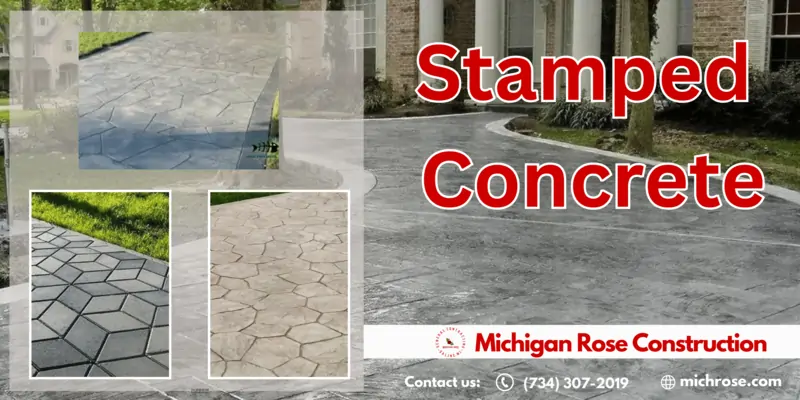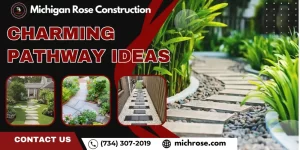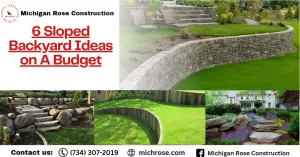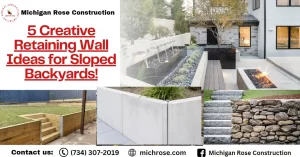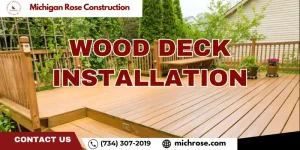Introduction
Your patio should be an extension of your living space – a welcoming place to relax, entertain, and make lasting memories. The sweet aroma of blooming flowers in the air, the glow of string lights overhead, and the peaceful ambiance of your personal outdoor oasis.
A patio has the power to transform your backyard into a sanctuary and gathering place. However, creating this idyllic space involves more than just patio furniture and plants. The patio surface itself plays a critical role in the aesthetics, functionality and enjoyment of the space.
Stamped concrete has emerged as a versatile, innovative solution for crafting beautiful, distinctive patios. This building material can be molded and patterned to mimic natural materials like stone, wood, brick and tile. With limitless customization options, stamped concrete allows you to design a patio surface that reflects your personal style. It’s durable enough to handle the elements while providing an eye-catching focal point to your outdoor living area.
In this guide, we’ll explore the world of stamped concrete – uncovering its unique benefits, design capabilities, installation process and more. By the end, you’ll see why stamped concrete deserves a spot at the top of your patio surface list, as an artistic yet practical material that can transform your space into a welcoming backyard oasis.
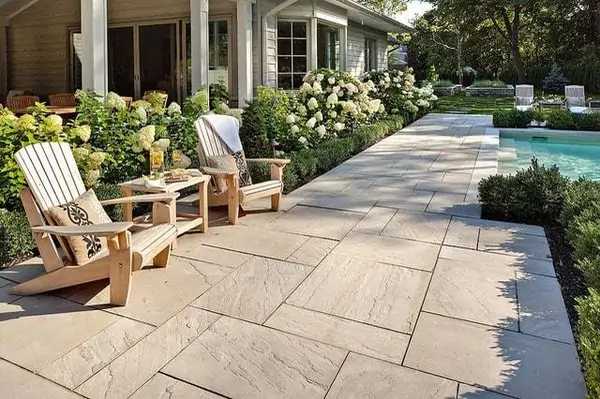
What is Stamped Concrete?
Stamped concrete is a versatile building material created by imprinting patterns onto freshly poured concrete to make it resemble natural materials like stone, brick, slate, and wood. Unlike conventional concrete that is smooth and gray, stamped concrete uses textured mats, stamps, or rollers to imprint designs and textures into the concrete surface before it fully cures.
The stamping process not only creates an attractive, realistic finish but also enhances the durability and strength of the concrete. Stamped concrete is most commonly used for outdoor living spaces like pool decks, patios, walkways, and driveways. It provides a low-maintenance and cost-effective alternative to genuine stone, brick, and pavers.
The unique process of stamped concrete involves:
- Pouring a base of conventional concrete
- Spreading color hardeners or powdered pigments onto the wet concrete
- Pressing textured mats into the concrete to imprint the desired pattern and texture
- Applying sealers to protect and enhance the finished design
The result is a highly customizable concrete surface that resembles natural building materials, with the durability to withstand outdoor conditions. Stamped concrete brings beauty, sophistication, and creativity to any landscape or hardscape design.
Benefits of Using Stamped Concrete for Patios
Stamped concrete offers numerous advantages that make it a top choice for patios:
Durability
Unlike natural stone, stamped concrete is less prone to cracking and chipping over time. The concrete mixture can be designed to withstand heavy foot traffic, furniture dragging, harsh weather conditions, and more. It won’t rot or splinter like wood decking either. Its unrivaled durability ensures your patio will look pristine for decades to come with minimal repairs needed.
Low Maintenance
Keeping your patio looking sharp doesn’t require intensive upkeep with stamped concrete. Just occasional pressure washing and resealing every 2-3 years will maintain its beauty. No need for constant sweeping, power washing, staining, waterproofing, or other maintenance like natural stone or wood require. The minimal maintenance needs make stamped concrete a great option for busy homeowners.
Design Versatility
From mimicking flagstone, slate, cobblestone, brick and other textures to incorporating colors and patterns – stamped concrete offers endless design possibilities. It can complement any style from Mediterranean to modern. Borders, bands, emblems, and more can be seamlessly integrated too. Stamped concrete provides a versatile canvas to create a patio that reflects your personality and design aesthetic.
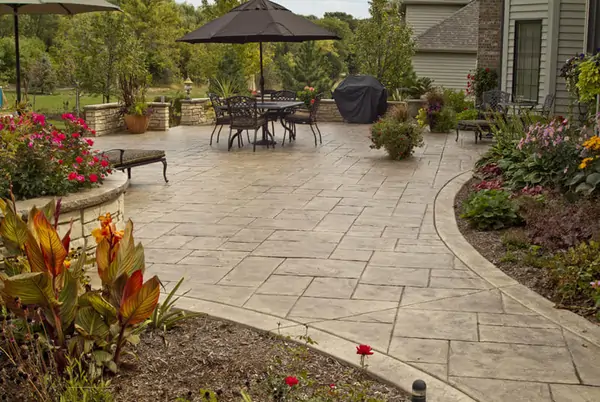
Mimicking Natural Materials
Stamped concrete is valued for its ability to replicate the look and texture of natural building materials like stone, brick, and wood. When stamped, concrete can take on the appearance of a vast range of materials while retaining the strength and durability concrete is known for.
The stamping process imprints realistic patterns into the concrete to mimic materials like:
- Flagstone – It can recreate the irregular shapes and earthy tones of natural flagstone for a rustic yet elegant look. The flagstone pattern brings visual interest through its varied shapes and sizes.
- Brick – For a classic, timeless look, it can be tooled to look like brick pavers. From traditional red brick to more modern grey and brown tones, stamped concrete provides the charming look of brick without the high maintenance.
- Slate – Cool grey and blue-grey slate patterns are easily achieved with stamped concrete. The slate design offers a sophisticated look perfect for patios and walkways.
- Wood planks – The warmth and natural beauty of wood can be replicated by stamping concrete to resemble wood planks. Realistic wood grain textures make this a popular choice.
The ability to mimic these prized building materials is what makes stamped concrete such a versatile design option for patios. It provides the natural visual appeal homeowners want without the upkeep issues of real stone, brick, slate or wood.
Concrete stamps by Brickform
Concrete stamps from Brickform can be repeatedly used to provide residential or commercial concrete a textured finish. Select from a range of grout lines, sizes, joints, and layouts.
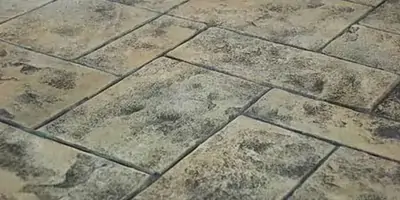
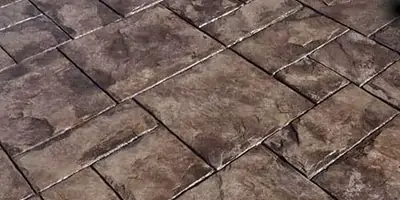
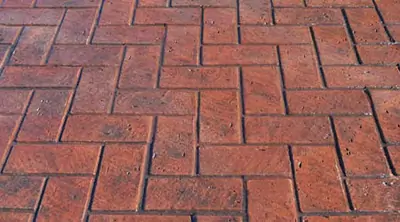
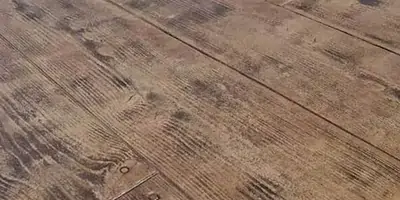
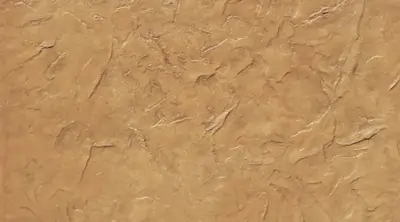
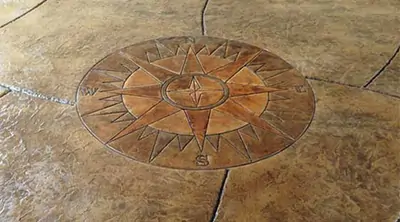
For your reference: Concrete Stamps
Customization Options
One of the most appealing aspects of stamped concrete is the immense range of customization options it provides for your patio. With stamped concrete, you can choose from a diverse palette of colors, textures, and patterns to create a look that aligns with your vision.
Colors
Stamped concrete offers a full spectrum of color choices to match any style. Earthy tones like beige, brown, and terra cotta evoke a natural vibe, while grays add an urban modern touch. Bold colors like reds or blues make a dramatic statement. You can even opt for a mottled effect by blending multiple colors together. This allows you to match existing color schemes or create unique combinations.
Textures
Textures add visual interest and dimension to your patio. Stamped concrete can mimic materials like stone, brick, slate, and tile. Rustic wood plank textures offer warmth and charm. Granite, limestone, and travertine patterns provide elegance. Abstract and geometric textures lend a contemporary flair. With countless options, you can find the perfect texture to complement your landscape.
Patterns
Stamped concrete isn’t limited to a single texture—you can imprint patterns by layering complementary textures and colors. Blend stone and brick textures in contrasting hues for rustic ambiance. Combine slate and tile patterns in muted tones for an elegant courtyard feel. Mix geometric shapes in bold colors for an artful look. The pattern possibilities are endless with stamped concrete.
With its unparalleled range of customization options, stamped concrete enables you to design a patio that brings your unique vision to life. Tailor colors, textures and patterns to create an outdoor oasis reflecting your style.
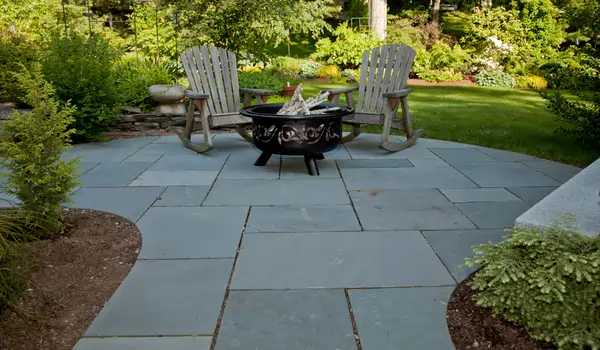
Design Considerations
When designing your stamped concrete patio, there are several factors to consider that will impact its functionality and aesthetic.
Climate
The climate of your region is a key consideration, as it will determine how well the stamped concrete withstands the elements. In colder climates subject to freezing temperatures, it’s important to use air entrainment additives during installation to minimize cracking and damage from freeze-thaw cycles. Stamped concrete also holds up well in hot, arid climates, though may require sealing to limit moisture loss.
Footprint
Take into account the size and layout of your patio when planning a stamped concrete design. Optimal performance is achieved when poured in larger slabs, so keep the footprint open rather than breaking it up into small segments. Also factor in spacing between stamped patterns and borders to maximize visual appeal. Allow enough space for desired patio furniture and accessories.
Accessibility
For wheelchairs, walkers, and strollers, take note of accessibility when designing a stamped concrete patio. A smooth finish is safest, and the patio should connect seamlessly to sidewalks or driveways, with very minimal lips or edges. Gradual slopes for drainage are preferred over sudden drops. This ensures your patio can be enjoyed by all.
Installation Process
Installing a stamped concrete patio requires careful planning and execution to achieve the desired aesthetic. Proper installation involves three key phases:
Prep Work
Before pouring concrete, the ground must be prepared to provide a solid foundation. This involves:
- Excavating the area to reach stable soil, removing any organic material or debris
- Installing gravel and compacting it to create a 4-6 inch sub-base
- Adding steel rebar to reinforce the concrete slab
- Building a frame to hold the concrete in place while curing
Any decorative accents like borders or decorative stones should be added during this prep phase.
Stamping
The concrete is poured and leveled, then stamping begins before it fully cures. Workers press mats into the concrete to imprint the desired pattern and texture. Release agents are applied so the mats don’t stick. An accent color can be added on top to highlight certain areas.
Stamping requires skill to evenly apply pressure and align imprints. Most projects use multiple stamp mats to create a varied, natural appearance.
Curing
Once stamping is complete, the concrete needs ample time to cure without being disturbed, typically 5-7 days. It’s essential concrete cures slowly and evenly to reach full strength. Temperature and humidity levels are controlled to prevent cracking.
A sealer is applied at the end to enhance durability and visual appeal. The patio can’t be used until fully cured and sealed.
Proper installation requires expertise, but results in a stunning, durable stamped concrete patio.
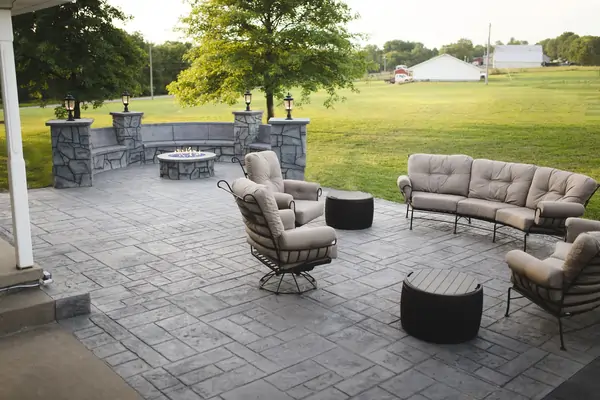
Cost Comparison
When it comes to your patio, you want to choose a material that fits your budget. Stamped concrete offers an affordable yet high-quality option compared to other popular patio materials like pavers, wood, and natural stone.
Stamped Concrete vs. Pavers
Pavers made of brick, stone, or concrete can be very expensive, with costs ranging from $10-50 per square foot installed. Stamped concrete only costs $8-18 per square foot installed. While pavers offer a classic look, stamped concrete can mimic the appearance of pavers for less.
Stamped Concrete vs. Wood
Wood decking has an attractive natural look, but requires frequent staining, sealing, and eventual replacement every 10-15 years. The installation and maintenance costs add up over time. Stamped concrete patios are a long-lasting alternative that avoids these recurring costs.
Stamped Concrete vs. Natural Stone
Natural stone like slate, bluestone, or granite is stunning but expensive, with costs from $15-50 per square foot. The high price tag is due to limited availability and quarrying costs. Stamped concrete provides the look of natural stone for a fraction of the price.
When weighing your patio material options, stamped concrete provides comparable aesthetics to these pricier alternatives at a budget-friendly cost. The initial investment is reasonable, and the long lifespan and low maintenance equate to long-term savings. Overall, stamped concrete’s affordability and durability make it a smart choice for patios.
Maintenance
One of the greatest benefits of stamped concrete is its low maintenance requirements compared to other patio materials. With just a little routine care, your stamped concrete patio can retain its beauty for many years.
Cleaning
Periodic cleaning is important for keeping your stamped concrete looking its best. Simply sweeping away dirt and debris regularly can prevent buildup. For a deeper clean, you can use a garden hose to rinse the patio. Avoid using a pressure washer, as high pressure water can damage the surface over time.
For tougher stains like oil or grease, use a concrete degreasing cleaner. Check the product label to ensure it’s safe for stamped concrete. Scrub the stain with a stiff broom and rinse thoroughly. Avoid acidic cleaners which can etch the concrete.
Sealing
Applying a concrete sealer every 1-2 years will protect your patio from wear. Sealers prevent stains, resist damage from salt and chemicals, and lock in the color to keep it vibrant. Use a high quality acrylic sealer made specifically for stamped concrete.
Before sealing, thoroughly clean and dry the concrete. Apply the sealer with a paint roller in thin, even coats. Allow each coat to dry before adding another. Two coats are usually sufficient. Be sure to only apply sealer when temperatures are between 50-90°F.
With periodic cleaning and resealing, your stamped concrete patio will retain its visual appeal and perform beautifully for many years to come. The minimal maintenance requirements make it a practical and long-lasting choice.
You mal also want to read: Concrete Driveway Replacement
Transform Your Patio
Stamped concrete offers a versatile, durable, and customizable paving solution that can elevate your outdoor living space into a stylish oasis. Here’s a summary of the key benefits that make it an ideal choice for patio projects:
- Aesthetic Appeal: Stamped concrete can mimic natural materials like stone, brick, wood, and tile at a fraction of the cost. With numerous pattern and color options, you can create a unique look that reflects your personal style.
- Durability: Properly installed stamped concrete is highly durable and resistant to cracking and chipping. It can withstand heavy foot traffic and furniture without showing signs of wear and tear.
- Low Maintenance: Unlike natural stone and pavers, stamped concrete doesn’t require yearly sealing or extensive cleaning. An occasional power wash is all you need to keep it looking like new.
- Customization: Stamping allows you to customize the shape, size, pattern, and color of the concrete. You can create unique designs like company logos, monograms, or decorative borders.
- Cost Effective: Stamped concrete provides the look of high-end building materials at a fraction of the price. The cost per square foot is comparable to poured concrete.
With its aesthetic versatility, durability, and easy maintenance, stamped concrete is a smart investment that can enhance the form and function of any patio. Bring your design vision to life and create an inviting outdoor living space with this innovative paving solution.
Ready to Get Started?
If you’re considering a stamped concrete patio for your outdoor space, consult with Michigan Rose Construction. They can guide you through the design process, answer your questions, and ensure a flawless installation that will add beauty and enjoyment to your home for years to come.
For more details, visit Michigan Rose Construction Facebook Page or you can call (734) 307-2019.

